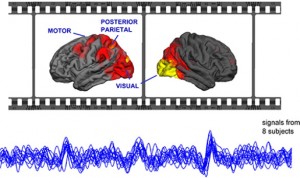

Next time you find yourself in a movie theater, consider this: You are probably sharing more than an armrest or a bag of popcorn with the person next to you; you are likely sharing brain activity, too.
In one fMRI study, moviegoers who watched The Good, the Bad, and the Ugly experienced increases and decreases of neural activity in tandem. As much as 70 percent of their cerebral cortex was synchronized at any given moment. This synchronization happened especially in brain regions responsible for processing sights and sounds, but was also evident in regions associated with emotion. Researchers observed correlations in the fusiform face area when subjects saw faces on screen. They saw synchronized activity in the limbic system’s cingulate gyrus, which connects actions with emotional responses. But why does this happen? Researchers attribute these correlations to the fact that people watching the same movies experience the same stimuli.
Movies that direct audience attention with structural devices are more likely than unstructured videos to elicit brain synchronization. Cuts and angle shifts greatly influence viewers’ eye movements, and information collected by retinal cells passes through the thalamus into the visual cortex at the back of the brain. Regions of the visual cortex have functions ranging from pattern recognition to motion perception. As a result, movies that exert more control over viewers’ perception have a greater impact on their brain activity. Unstructured videos like comedy shows, by contrast, elicit only 5 to 20 percent cortical synchronization among viewers.
Great films may not be mind control, but they certainly come close.
